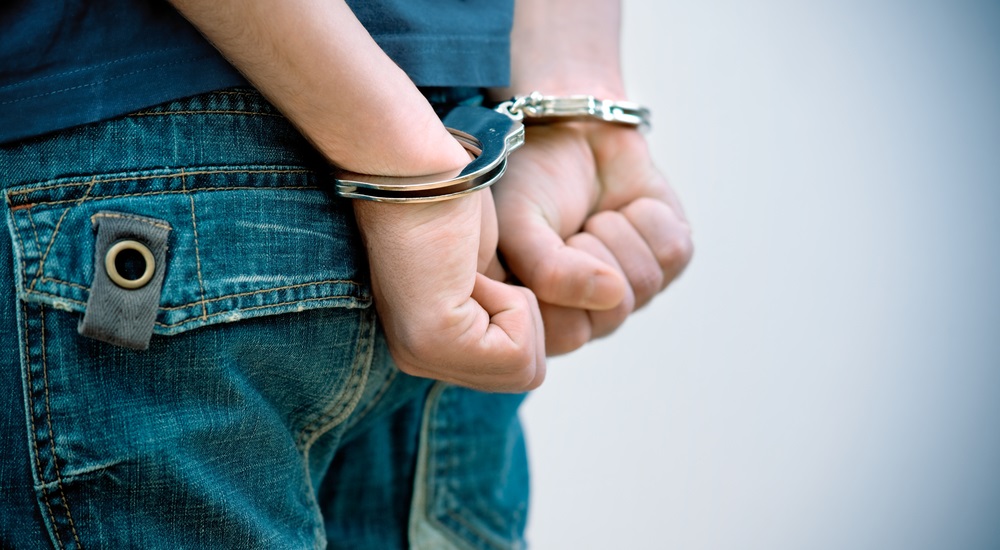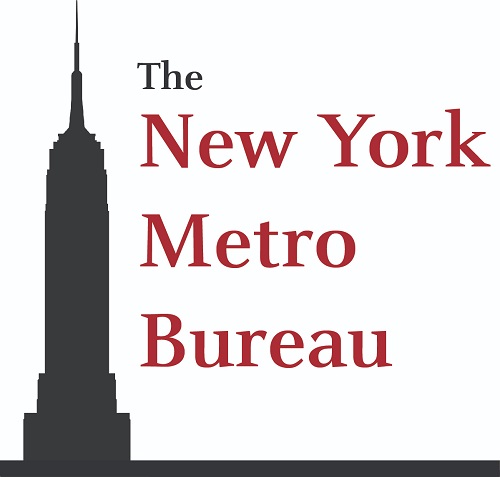 ALEXANDER RATHS/SHUTTERSTOCK
ALEXANDER RATHS/SHUTTERSTOCK
NEW YORK — In 2017, a disabled 8-year-old Latino boy was sitting at his school lunch table with other students. They were playing with a spork, poking each other. The boy, who was being excluded, decided to poke the other children anyway, causing school staff to take it away. The staff became frustrated and called in school safety agents to diffuse the situation.
 The agents were unable to calm the child down and instead called the police. New York Police Department officers came to the school and handcuffed the boy, ripping his pants in the process. He was left in handcuffs for a few hours.
The agents were unable to calm the child down and instead called the police. New York Police Department officers came to the school and handcuffed the boy, ripping his pants in the process. He was left in handcuffs for a few hours.
Even after he had calmed down and his parents arrived at the school, he was not released into their custody. Instead, he was taken to the emergency room in an ambulance while handcuffed for a psychiatric evaluation.
The boy was released by doctors, who said he posed no threat to himself or others and that it was not medically necessary for him to be at the hospital, according to a data brief from Advocates for Children of New York.
Similar incidents have happened at city public schools across the five boroughs. Over 1,500 students were restrained by school safety agents of the NYPD from the first quarter of 2019 through the first quarter of 2020, according to data released by the agency. On average for the analyzed year, 89% of those restraints were of nonwhite children.
“Right now, we have more school safety agents than we have guidance counselors and social workers combined,” said Johanna Miller, director of the Education Policy Center at the New York Civil Liberties Union (NYCLU). “And that’s just a completely wrong prioritization system.”
Why are children restrained in school?

Johanna Miller
Students can be restrained for multiple reasons including their upcoming arrest for allegedly committing a crime, school disciplinary intervention for offenses like fighting and child-in-crisis incidents.
A child-in-crisis incident is when a student shows signs of emotional distress and staff determine they must be removed from school and taken to the hospital for psychiatric evaluation. A wide range of incidents can fall under this definition, including a mental health crisis, refusing to return to class or yelling at and kicking teachers and classmates. Usually, the NYPD and school safety agents deem these children to be a risk to themselves or others and restrain them.
“Child-in-crisis is like you’re having suicidal ideation or you’re like, you know, disassociating from reality or having a breakdown of some sort,” Miller said. “In 9% of those cases, kids were handcuffed. That to me is a scandal.”
That restraints are used in a small minority of cases is far less significant than the fact that they are used at all on young children, she indicated.
Miller has been advocating in New York City for changes to school safety for over a decade. She spoke about school safety agents’ use of force before the City Council in 2017, but in 2020, not much has changed, she said.
Restraints the NYPD uses
The NYPD, which oversees school safety, releases data to the public each quarter on incidents in schools, including if restraints were used in each interaction.
Either metal or Velcro restraints are used on students. Metal restraints are simply regular handcuffs; Velcro restraints are strips of cloth almost 2 feet long with Velcro fasteners that can be adjusted to the size of a person’s wrist. The Velcro cuffs are supposed to be used on children under age 12.
The NYPD first approved the use of Velcro cuffs on students under 16 in 2009 when it started a pilot program allowing their use at 22 schools in Queens. An article from the New York Daily News in 2009 said the cuffs were to be used to subdue “disturbed or unruly children.”
“We would prefer never to use restraints of any kind, but in those rare instances where it may become necessary, we want a softer alternative to conventional handcuffs,” said Deputy Police Commissioner Paul Browne in the 2009 article.
After repeated attempts, the NYPD did not respond when asked about handcuffing students.
The rules about handcuffing those under 16 changed in a new memorandum of understanding approved in 2019. The memorandum of understanding, which establishes the relationship authorizing school safety to be overseen by the NYPD, dates back to September 1998. A new memorandum is created every few years, outlining the agreement between the agencies.
“Metal handcuffs should not be used on students younger than 12 years of age without prior approval of the precinct school safety sergeant, patrol supervisor or school safety supervisor, whenever possible,” the 2019 document reads.
But, Miller says this clause in the document is unclear.
“It says, metal handcuffs are not supposed to be used if you’re under 12, without prior approval, and then it says whenever possible. So it’s like it’s a ‘should not be used,’ not a ‘must not be used.’ And then it’s ‘without prior approval,’ and then ‘whenever possible,’” Miller said.
In plain English, if a student is under 12, metal cuffs should not be used on them — but data from the last year shows that this guideline is not always followed.
In the first quarter of 2019, a Black 6-year-old was restrained with metal cuffs. In the second quarter, metal restraints were used on students aged 5 to 10 five times. In the last quarter of 2019, three students aged 10 and under were restrained with metal cuffs.
All of these restraints were during child-in-crisis incidents.
Schools with the most child-in-crisis incidents
Some schools throughout the city are impacted more than others, with a majority of the schools with the most incidents in the Bronx.
Students in District 75 schools or programs are also greatly impacted. Students in this district require a specialized education as they may have autism spectrum disorders, sensory impairments, emotional disturbances, significant cognitive delays or multiple disabilities. Out of the eight schools listed above, four are considered to be District 75.
These schools also reflect other findings that show students of color are disproportionately impacted in these cases. For example, the J.M. Rapport School for Career Development is only 3% white, according to the City's Department of Education. The schools with the most child-in-crisis incidents are on average 2.7% white.
In the 2018-19 and the 2019-20 school years, which encompass the dataset analyzed, only 15% of students in the public school system were white. Both school years, 41% of students were Hispanic, 26% were Black, 16% were Asian and 3% of students identified as having multiple ethnicities.
Over 1,500 students were restrained during the five quarters analyzed, with only 5.3% of those students white. Of those 1,500 incidents, 386 of them were for child-in-crisis incidents.
The remaining 1,100 or so students were restrained either because of arrests, summonses or behavior that resulted in them getting in trouble at school. Of the 386 restrained students, 360 were nonwhite.
Council Member Adrienne Adams, a Democrat who chairs the committee on public safety, expressed concern when asked about the disparity.
“The rate of NYPD restraint of students of color during mental and emotional crises in school are alarmingly disproportionate. We need a fresh approach for classroom management which should not include the NYPD,” she wrote in a Jan. 12 email. “While having school safety agents under the NYPD umbrella may create the appearance of safety, the impact of an overpoliced school environment can potentially fuel problems for years to come.”
Breaking down the data, it becomes clear that students of color are restrained more frequently. On average, 89% of students restrained were students of color.
When asked about this disproportionate impact on students of color, the Department of Education did not respond to requests for comment. The NYPD also did not respond to multiple requests regarding restraining students.
2015 sees changes to laws, DOE rules
After a 2013 court case, T.H. et. al v. Farina et. al, which focused on students being transferred to hospitals during child-in-crisis incidents by emergency services, changes to laws and DOE rules were made.
The court case resulted in changes to Local Law 93, amending the city’s administrative code to include more mandatory reports on student discipline and emergency transports, and created a new chancellor’s regulation in 2015. Under the new rule, parents can request their child not be taken to the hospital, but the on-scene 911 responders make the decision. The rule took effect just in time for the 2015–16 school year and is still in effect.
Another clause in the Chancellor’s Regulation says 911 calls should not be used as a disciplinary measure because of a student’s behavior or as an alternative to de-escalation strategies.
Local Law 93 was also changed: As of 2016, a citywide report is required on emergency medical service student transports.
What is New York doing about school safety?
This year school safety is supposed to return to being overseen by New York City's Department of Education. A variety of youth advocacy organizations are working to make sure this actually happens.
The NYCLU is working to make sure the transition is not just a transfer, but a transformation of school safety practices, including changing the department’s culture, Miller said.
Dawn Yuster and her organization, Advocates for Children of New York, are calling for a mental health continuum to be established in schools with high rates of child-in-crisis cases. This model was developed by the Mayor’s Leadership Team on School Climate in 2016, which urged the city to adopt it. Last year, the City Council and other advocacy groups recommended it for high-needs schools but there was not enough money in the budget to adopt it.

Dawn Yuster
This model includes a team of clinicians working with students and school staff to determine the appropriate level of care. It coordinates with schools to respond to students in crisis while working to enhance each school’s capacity to respond to students’ mental health needs.
What’s already in place is that each school’s crisis intervention team must complete a crisis de-escalation plan as part of its consolidated school and youth development plan, which must include strategies for de-escalating behavior. The plan must also identify in-school and community resources that are available to the school and parents, such as mental health clinics, mobile crisis teams and facilities that provide urgent or same-day mental health assessments.
“I think there's a disconnect between what's happening on the legal level and the school level and being able to tap into resources and really help staff in live time as trainers and administrators,” Yuster said.
A transition team is working on developing a plan for the multiyear transition, said Nathaniel Styer, deputy press secretary for the city's Department of Education. He also stressed the importance of reimagining school culture.
“We prioritize creating school environments that are welcoming, inclusive and safe for all of our students, and our work on bringing SSAs [school safety agents] back to the DOE underscores our commitment to communities built on trust and respect, not discipline and policing. This transition is a moment for all of us to reflect on our shared responsibility to do better for students, and double down on trainings in de-escalatory practices, addressing implicit bias, and creating cultures built on respect and support," he said.
Bridge to School plan: A great start?
For the 2020–21 school year, the city announced a targeted mental and emotional health plan, triggered by the pandemic. Approximately 13,000 people were trained throughout the spring and summer in a Trauma 101 series focused on grief and loss, bereavement and self-care in a crisis, according to the Department of Education.
The city touts moving away from a punitive approach to school safety and instead has increased access to social-emotional learning support, expanded restorative justice practices, provided support and training for educators and administrators and hired school response clinicians to provide immediate clinical support to students in crisis.
New York first lady Chirlane McCray has made mental health her focus during the de Blasio administration. She worked on the controversial ThriveNYC, which promotes mental health for New Yorkers, and worked on the Bridge to School plan.
“When we brought social and emotional learning to every New York City classroom last year, it was built on a simple concept: Children learn best when they are healthy and have a sense of emotional well-being,” McCray said. “This expanded approach integrates social emotional learning into the curriculum to reach students, provides trauma-informed training for more teachers and resources for teachers and principals to manage blended learning.”
Yuster, who called for increased training and access to mental health resources with other organizations back in April, called this plan a great start.
“That’s what this is all about. I mean, the benefits, the rewards, are just intangible, because they’re exponential. Because it means that you’ll have people who will be able to really negotiate conflict and interpersonal relationships in a really healthy way,” she said.
But much is still up in the air. School safety is still run by the NYPD and will be until a new plan is created. So what are people looking for in a new system? Miller, who is working to develop a plan, knows what the NYCLU wants.
“A school culture where the students are respected, where they’re part of a city that cares about them, where they have trusted relationships with adults, and it’s hard to have a trusted relationship if you’re not sure if you’re going to get handcuffed.”































